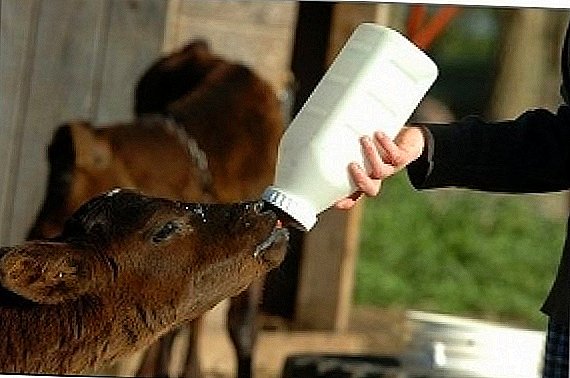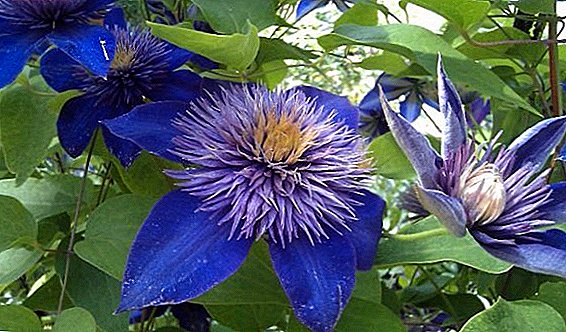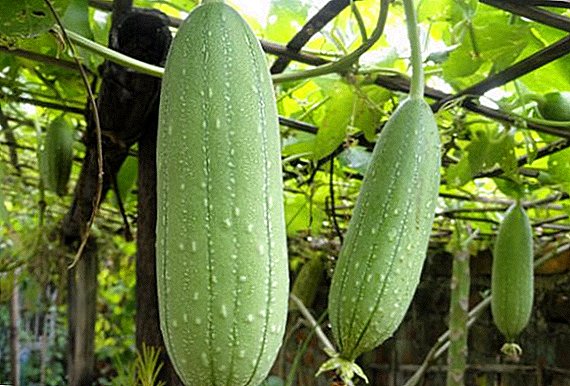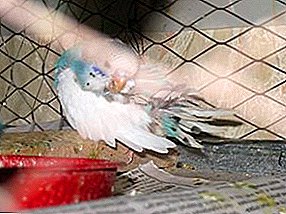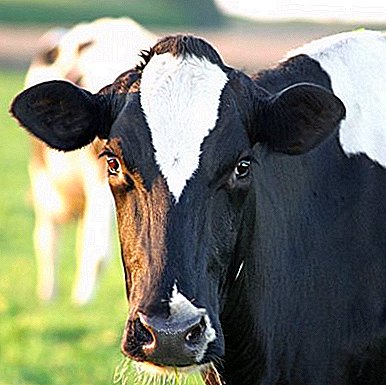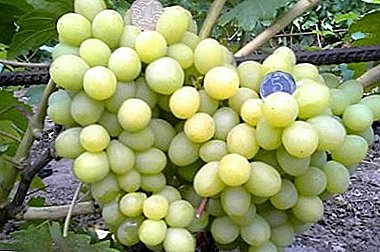 Wolf aconite is a very life-threatening, but incredibly beautiful plant, which causes the experienced gardeners to want to place it on their site. Let's see what aconite is, what are the features and rules of planting this plant, what are the ways of its reproduction.
Wolf aconite is a very life-threatening, but incredibly beautiful plant, which causes the experienced gardeners to want to place it on their site. Let's see what aconite is, what are the features and rules of planting this plant, what are the ways of its reproduction.
Plant description
Aconite Wolf ("wrestler", "wolf root", "wolf") - a perennial grassy poisonous plant of the Buttercup family. It has straight stems, beautiful flowers and alternating long-leaf leaves.
Many poisonous plants are used as medicine, and aconite is no exception. It is used to make various tinctures that have soothing, analgesic and antispasmodic properties.
This plant received such a name because it was previously used to poison the wolves. In ancient times, the Greeks and the Chinese made a poison to lubricate their arrows from aconite. Nepalese lured predators with his help, poisoning the drinking water with a wrestler.

Important! Alkaloids, which are contained in the flower, make it toxic. Influencing the central nervous system, they cause paralysis of the respiratory center and convulsions.In modern medicine prohibited use of a wrestler. However, in Tibet, the plant was called the "king of medicine" and he was treated with pneumonia and anthrax. In Slavic countries, traditional medicine used this herb as an external painkiller.
Where does wolf aconite grow?
The most common types of aconite in North America, Europe and Asian countries. Most often, wolf root can be found on the roadsides, on wet places near the river banks, on mountain lawns, and also on humus-rich soils. Aconite is a perennial herb, and if it grows on fertile garden soil, then after a few generations lose its toxic propertieswhat will be on hand to gardeners.
Did you know? Homeopaths use drugs based on the fighter as antipyretics. They are also used to overcome climacteric hot flashes by women.

Landing features
If you are not afraid of poisoning and yet decided to start planting and caring for aconite in the open field, then it is very important to know all the rules for growing this plant. A wolf can coexist with any other flowers and grass, as it does not carry danger for ornamental plants. You should not plant it next to the vegetables and fruits that will be eaten.
Shade-tolerant perennial plants are also: astilba, brunner, dicentre, doronicum, volzhanka, lily of the valley, lupine, rogeria, saxifrage, cyanosis, host, bathing vessel, symphian.
Location selection
When choosing a place for a wolfboy, you need to consider that he likes moisture, but does not tolerate stagnant water. Wolf root can grow in the shade and on a sunny plot. However, it is better to plant curly varieties of this grass under trees, as the direct rays of the sun can cause burns in a curling wrestler.
Landing rules
Planting and transplanting a wolf is best in the fall or spring, when its stems are cut or not yet grown. Cut it should be so that each young escape had 2-3 buds.

The planting pit should be of such a size that the rhizome of the plant will fit freely in it. The plant will survive the planting better, if you fall asleep in the pit 15-20 g of mineral fertilizer. Root plant neck need prikopat 1-2 centimeters. The distance between the bushes during planting should not be less than 25-30 centimeters.
Important! Do not plant wolf aconite on your plot if you have pets and children, as their accidental contact with the plant can lead to poisoning and death.
How to care for a plant?
Caring for a wolfboy should be the same as for any other flower: loosen the soil, feed, remove weeds and water. Also in the care of aconite includes removal of dried inflorescences. In the autumn, the wolf is shortly cut and its rhizome is peppered by peat about 20 centimeters.
Soil care
Places where wolf aconite grows need loosen and weed all summer. Mulching of the soil on which the wrestler grows should be carried out 1-2 times per summer and at the same time use cut grass to retain moisture. Despite the fact that the wolfish aconite is very poisonous to humans and animals, insects, diseases and pests do not bypass it.
Did you know? Plutarch argued that the warriors of Mark Antony, who were poisoned with the help of only the smell of this plant, lost their memory.

Grass can hit:
- rape flower beetles;
- aphid;
- slugs;
- nematodes.
- powdery mildew;
- ring mosaic;
- spotting;
- greening flowers.
In folk medicine, other poisonous plants are also used: bathing, wolves, swimsuit, autumn crocus, dodder, berry yew, rue.
Watering and feeding
Winter is very important fertilize the plant with biological products at the root, as with the stagnation of moisture is likely the death of aconite. As soon as the grass begins flowering period, it is necessary to feed it with mineral and organic fertilizers. In times of summer drought, you need to water a wolf. To make flowers brighter, gardeners are advised to make a small dose of compost for each bush in the spring.

Removal of peduncles
In order for a wolf to acquire a decorative appearance, it is necessary to remove the inflorescences that have already faded. This provides stimulation of new flowering. To collect seeds from a plant you need to choose the most beautiful inflorescences.
Did you know? In folk medicine, the wrestler is most often used as a rubbing from pain in the joints.
Breeding methods
The easiest way to propagate the wolf root in a vegetative way is the division of rhizomes, daughter tubers, cuttings. In the spring or autumn season, the bush is very easy to divide into parts and plant.
For propagation by cuttings, young grass shoots should be used, having a height of no more than 12 centimeters, which usually appear in spring from overwintered tubers. If you take a more mature cutting, there is a high probability that due to lignification it will not take root. To aconite better bloomed, you need to multiply and transplant it to a new soil every four years.
You can multiply wolf aconite and seeds. However, it will take at least a year to germinate, since the seed buds of this grass are poorly developed. In order for the seeds to germinate more quickly, experienced gardeners conduct a pre-sowing preparation - a stratification procedure (imitating the influence of natural winter conditions on grass seeds). Flowering seedlings should be expected only in the second or third year of their life.

Precautionary measures
To avoid unpleasant consequences, it is necessary to warn all guests of the garden plot about the presence of poisonous grass. It is necessary to warn small children that it is impossible to tear off the wreath flower stalks. If contact with the plant does occur, it is necessary to thoroughly clean the place of contact with soap.
Important! In case of poisoning by a wrestler, immediately call an ambulance. And before doctors arrive, drink plenty of salt water, activated charcoal, and try to induce vomiting.A wolf is a beautiful grass that many gardeners dream of planting in their country house. However, in order not to get poisoned, it is necessary to follow all the rules of planting and caring for him.


